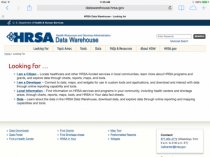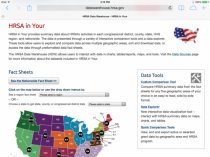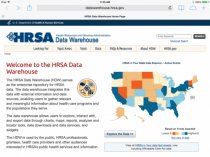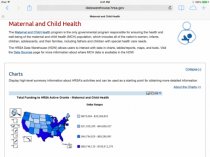National claims data Warehouse
The Health Resources and Services Administration (HRSA) is responsible for improving access to health care for the nation's poor and underserved, while delivering funding and support to medical professionals who care for those affected communities. More than just a repository for the agency's data, the HRSA Data Warehouse (HDW) allows visitors to explore and use a wide range of health data through interactive, customizable tools such as charts and maps. Though its innovative tools offer tremendous advances in specialized data utilization – enabling designers to work with HRSA’s data in new and collaborative ways - the HDW struggles to immediately connect to audiences with more commonplace health information needs and varying digital skills.
Figure 1
 The HDW home page [figure 1] offers several points of entry to HRSA data, encouraging site exploration via keyword search bar and interactive US map, which links to state-level datasets. The main menu provides access options driven by the user's skills and interests: About HDW offers contact information and a site map; the FAQ link includes video and PDF tutorials in site purpose and functionality. Data can be searched by Topic Areas or Tools, with additional portals to those options near page bottom. Though the two most basic information needs addressed by HRSA, "Find a Health Center" and "Find Grants, " are hidden at the bottom of the page, the main menu's Looking For link also directs users to appropriate resources related to those particular queries.
The HDW home page [figure 1] offers several points of entry to HRSA data, encouraging site exploration via keyword search bar and interactive US map, which links to state-level datasets. The main menu provides access options driven by the user's skills and interests: About HDW offers contact information and a site map; the FAQ link includes video and PDF tutorials in site purpose and functionality. Data can be searched by Topic Areas or Tools, with additional portals to those options near page bottom. Though the two most basic information needs addressed by HRSA, "Find a Health Center" and "Find Grants, " are hidden at the bottom of the page, the main menu's Looking For link also directs users to appropriate resources related to those particular queries.
The Looking For portal [figure 2] enables visitors to identify themselves by information need, directing them to data of interest. I Am a Citizen helps people locate health care and learn about HRSA programs and grants. Address information entered in the Find a Health Center tool produces geographical data as a pinned interactive map, with contact information for nearby HRSA-supported medical facilities. For health care professionals, information links on Grant Opportunities and Loans and Scholarships refer the user back to appropriate pages on HRSA.gov containing a wealth of resources. Many features allow users to discover the agency’s diverse efforts in detail: for example, the HDW's Chart Gallery divides individual HRSA programs into 16 charts, providing a visualized starting point for further information seeking. The Maternal and Child Health Chart [figure 3] color-codes those particular HRSA grants on the US map, with links to more information about the program.
Many features allow users to discover the agency’s diverse efforts in detail: for example, the HDW's Chart Gallery divides individual HRSA programs into 16 charts, providing a visualized starting point for further information seeking. The Maternal and Child Health Chart [figure 3] color-codes those particular HRSA grants on the US map, with links to more information about the program.
Figure 3
The I Am a Developer channel enables citizen participation via downloading of HRSA data, maps, and widgets. The Active Grants Data Download delivers data in portable, usable Excel and CSV formats. By accompanying the raw data with instructional information on various map and web services, the HDW provides several levels of information resources, encouraging the use and dissemination of this data for the benefit of others.
You might also like

|
Cardiac Surgery in the Adult, Fourth Edition Book (McGraw-Hill Professional)
|
Survey: IT and business at odds on defining big data success — TechTarget
Data warehouse vendors will feel the burn. Hadoop and NoSQL products probably won't replace the enterprise data warehouse, but they are competing for workloads.

|
Leviton 51120-3R 120/240 Volt Panel Protector 4-Mode Protection, Light Commercial/Residential Grade, In NEMA 3R Enclosure Home Improvement (Leviton)
|

|
WD Red 3 TB NAS Hard Drive: 3.5 Inch, SATA III, 64 MB Cache - WD30EFRX Personal Computer (Western Digital)
|

|
Root Cause Analysis: Improving Performance for Bottom-Line Results, Fourth Edition Book (CRC Press)
|

|
Omron 10 Plus Series Upper Arm Blood Pressure Monitor with ComFit Cuff Health and Beauty (Omron)
|






